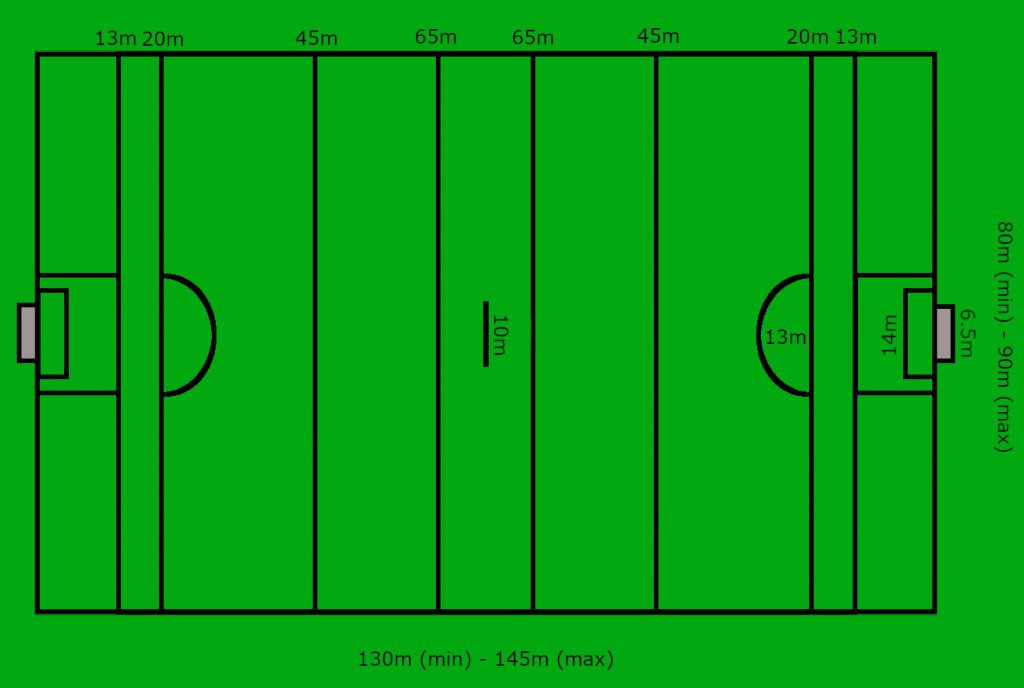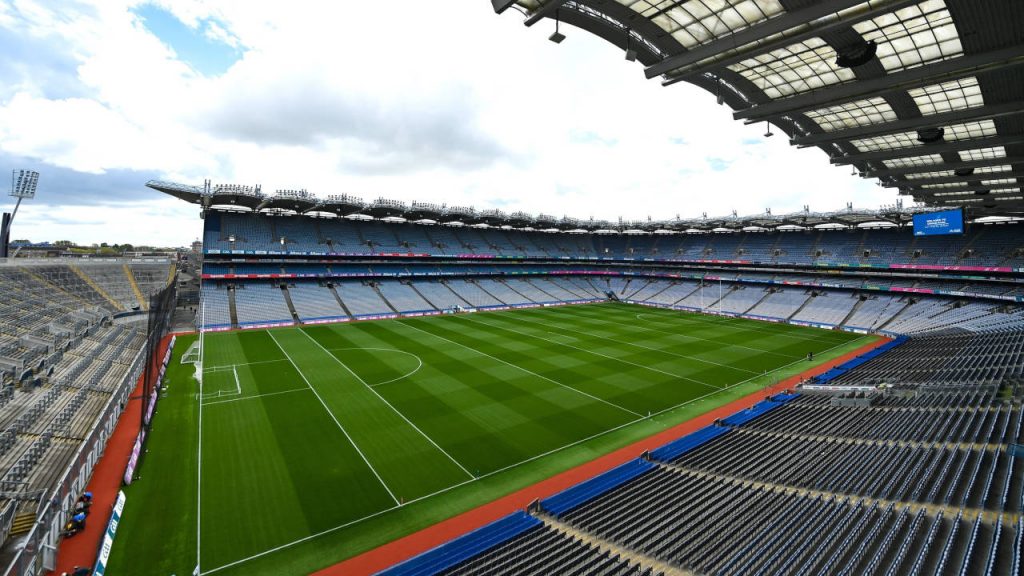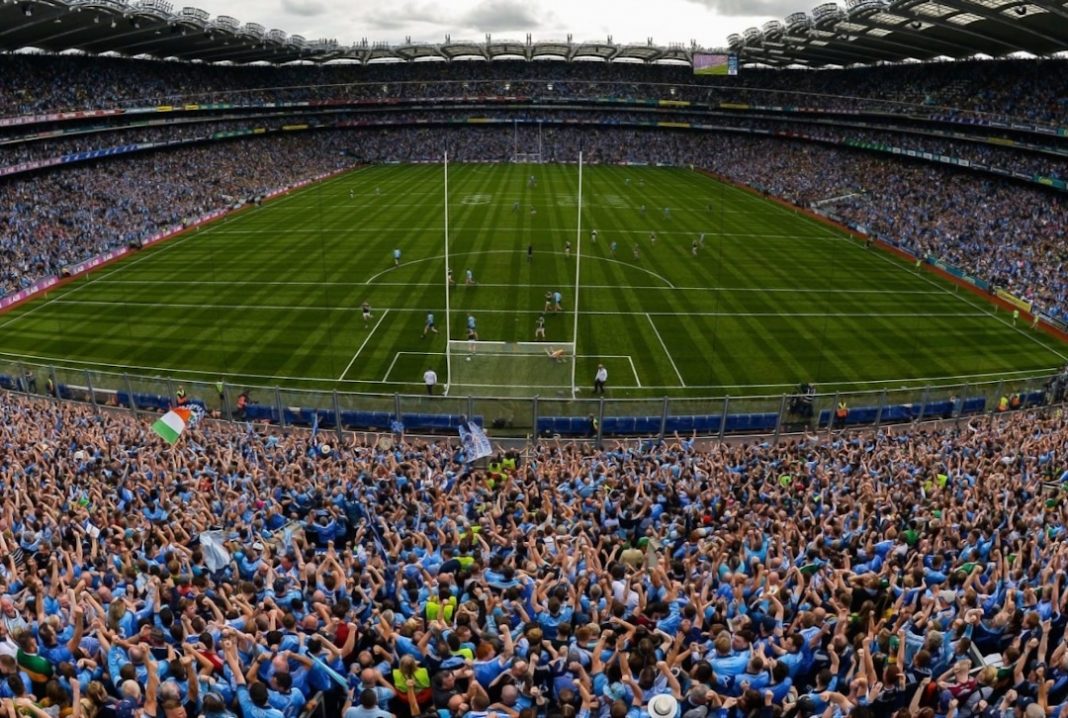GAA Pitch Dimensions
As with most sports, there are specific rules for the GAA Pitch Dimensions. That does not mean that every GAA pitch will be the same size. Rather, there is an established boundary in both width and length for a pitch. Some Gaelic clubs will have short and wide pitches, and others can have narrow and long.
GAA pitch dimensions vary between 130-145 meters in length. The longest possible Gaelic pitch in the league is 145m. Any field of play longer than this measurement would not be legal. There are similar restrictions for the width of the playing surface. The width of a GAA pitch must be between 80-90 meters. That means the narrowest legal pitch is 80m wide, and the official rule book does not permit less.
GAA Pitch Layout
Even though there is a narrow range for GAA pitch dimensions, each field of play will vary. One aspect of these pitches that cannot vary is the layout. The white lines painted on the field are identical across Ireland, and they start 13 meters out from the goal line. After that, there is an additional line 20 meters out, where they add a semicircle towards the halfway line. Before you get to the halfway line, there is a 45-meter line. This is one of the most important lines on the pitch as a lot of restarts occur from the 45. There is also a 65-meter line before we get to the middle of the park.
At approximately 70 meters is the halfway line. This is where the referee will throw the ball up in the air for players to contest and start the game. This area is also important for the duration of the match, as any fan of the sport would know. Controlling the midfield is a demanding job, and only the best Gaelic footballers of all time have been successful in doing so. You can also read more about the midfield by looking into our explanation of the GAA positions.

Out of all these measurements, you will find every pitch has the 45-meter line in the right place. That’s the same for the lines surrounding each goal and the 13-meter line. The halfway point is the only line on a GAA pitch that can change, as that varies depending on the length of the pitch. On wider or thinner pitches, all these lines remain in the same place.
GAA Pitch vs Soccer Pitch Dimensions
Your average GAA pitch is wider and longer than a traditional soccer pitch. Soccer pitches are far more lenient with their legal width across the major leagues. A playing surface in soccer ranges from 90 to 120 meters long and 45 to 90 meters wide. Some soccer pitch dimensions take advantage of this flexibility, allowing the home team the advantage of a wider playing surface to stretch the play. Since the boundaries for a legal pitch are much stricter in GAA events, this advantage is not as noticeable.
The average soccer pitch dimension is 105 meters by 70 meters. That means your typical soccer pitch is considerably smaller than the GAA field of play. The main reason for this difference is the number of players allowed on a team. Gaelic sports allow 15 players on a team, whereas there are only 11 soccer players. Your average soccer pitch has a playing surface of 7,350 meters squared. A GAA pitch has a much larger surface area of around 12,000 meters squared. That means your typical Gaelic football or hurling match takes place on a field almost twice as expansive as soccer.
Length of GAA Pitch
GAA pitches vary in length by up to 15 meters. That means the absolute biggest fields will be 145 meters in length. The official rule book states anything longer than 145 meters is not legal. The width of a GAA pitch is a much tighter margin, as it can only be between 80 and 90 meters.
Now, if a game takes place on a pitch that does not meet the requirements, one of several things may happen. They could annul the result of the match and force a replay in a legal setting. However, given the result of the All-Ireland Senior Club Football final in 2023, I would not get your hopes up. For anyone in the dark, the Kilmacud Crokes finished with more than the legal number of players on the pitch. Glen protested the outcome, but the result still stands. In the lower leagues, a rematch is easier to schedule. But at the top flight, logistics make replays almost impossible.
In most situations, a GAA pitch would have to be widely out of proportion for any real action to take place, and that would also not happen. Games on illegal pitches would not take place, and there would be public outrage if anything like that happened in the modern game.
Do GAA Pitch Dimensions Change?
No, but the pitches can vary at each GAA club. Some counties will have pitches that are shorter than average, and others will try to make use of the full 90 meters allowed. Typically, the average GAA pitch dimension is 137 meters long and 83 meters wide. There are multiple pitches in Ireland with bigger dimensions than that, one of them being Croke Park.

Many passionate fans have argued that Croke Park’s pitch is too big. The most important venue in Gaelic sport has a larger-than-average-sized pitch, measuring approximately 145×88 meters. That has led to many fan theories that players struggle to adapt to a pitch of this size as it promotes more space to attack. However, people often forget that it’s the same advantage for both sides. Some just handle the occasion better.
They reserve Croke Park for the biggest occasions, so a big pitch does not seem like an enormous deal to us. Yes, there will be superstitious people moaning that it benefits the big teams, but Croke Park is not the biggest GAA pitch out there. Last year, RTÉ reported there were six pitches at the maximum size in terms of length and width. The biggest GAA pitches in Ireland include:
- Pearse Stadium
- Semple Stadium
- Dr Hyde Park
- Cusack Park
- O’Connor Park
- Ballybofey
We want to see bigger pitches as that encourages better plays. A tight pitch is easier to defend and forces a “bear hug” approach to the game, where players are too close together and they stifle all creativity. Big pitches create space. Space means chances, and chances are what we are all here to see!





